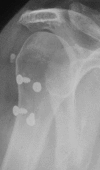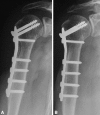No recurrences in selected patients after curettage with cryotherapy for grade I chondrosarcomas
- PMID: 20054673
- PMCID: PMC2881994
- DOI: 10.1007/s11999-009-1211-1
No recurrences in selected patients after curettage with cryotherapy for grade I chondrosarcomas
Abstract
Background: The low aggressiveness of Grade I chondrosarcomas is compatible with conservative surgical treatment.
Questions/purpose: We asked whether combined curettage and cryotherapy would yield low rates of recurrence and whether supplemental internal fixation would retain function with low rates of complications in patients with Grade I central chondrosarcomas of the proximal humerus or distal femur.
Methods: We retrospectively reviewed 15 patients: nine women and six men with a mean age of 45 years (range, 26-70 years). All patients underwent curettage and cryosurgery through a cortical window; we replaced the window and plated the region with at least three screws beyond the curetted area. None of the patients was lost to followup, and 14 patients (93%) were reexamined by us after a minimum of 5 years (mean, 8 years; range, 5-11 years).
Results: There were no perioperative anesthetic, neurologic, hardware, or healing complications. None of the patients had local recurrence or metastases develop. At last followup, the Musculoskeletal Tumor Society score was 27.9 (range, 22-30) and all patients had resumed their previous activities. No complications were associated with this simplified cryotherapy technique.
Conclusions: The data confirm the appropriateness of conservative surgery for central low-grade chondrosarcomas of the proximal humerus and distal femur based on a combination of intralesional curettage and cryogenic parietal sterilization. Candidates for this approach should be chosen on the basis of the affected bone site, local extension staging, and clinicopathologic grading. We recommend supplementary internal fixation.
Level of evidence: Level IV, therapeutic study. See Guidelines for Authors for a complete description of levels of evidence.
Figures





References
-
- Eefting D, Schrage YM, Geirnaerdt MJ, Le Cessie S, Taminiau AH, Bovée JW, Hogendoorn PC, EuroBoNeT consortium Assessment of interobserver variability and histologic parameters to improve reliability in classification and grading of central cartilaginous tumors. Am J Surg Pathol. 2009;33:50–57. doi: 10.1097/PAS.0b013e31817eec2b. - DOI - PubMed
-
- Enneking WF. A system of staging musculoskeletal neoplasms. Clin Orthop Relat Res. 1986;204:9–24. - PubMed
MeSH terms
LinkOut - more resources
Full Text Sources
Medical
Research Materials

